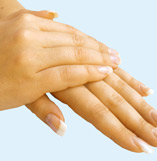Carpal tunnel release
What is Carpal Tunnel Disease?
The 'carpal tunnel' is a groove in the palm side of the bones at the wrist, which has a rigid fibrous roof. Running through this are tendons that are used to bend the fingers, and the median nerve, which supplies sensation to the thumb, index and middle fingers. Carpal tunnel syndrome occurs when the median nerve becomes compressed in this tunnel. In many people there is no cause for this, but it may occur with rheumatoid arthritis, pregnancy, diabetes, thyroid disease and other conditions.
Carpal tunnel release opens the tunnel and reduces the compression on the nerve allowing its recovery.
Why have a carpal tunnel release?
This compression of the nerve leads to reduced sensation in the fingers, tingling, 'pins and needles', weakness and loss of dexterity. Pain may also be a problem with advanced carpal tunnel syndrome. It leads to difficulty with everyday tasks, such as fastening buttons, writing, holding the telephone. Depending on the degree and length of compression, a good recovery can be expected.
Reasons not to have it
Aspirin increases the risk of bleeding by preventing blood from clotting. If you are taking aspirin, you will be asked to stop this for at least ten days before the procedure.
Further information
Consultation
Mr Roblin will want information about the symptoms that you are experiencing. He will want to rule out any problems higher up in your arm or your neck, which can also mimic carpal tunnel syndrome. He will then examine your function and sensation.
He may also recommend a period of physiotherapy or wearing a splint prior to surgery.
You will be asked about your general health, particularly information regarding heart disease, diabetes, and deep vein thrombosis (clots in the leg). Mr Roblin will want information about your medical history and any previous surgical procedures.
Procedure
An incision is made longitudinally on the palmer surface of the wrist. This is continued down through the fibrous roof of the tunnel to release the pressure on the nerve. The skin is then sutured closed.
Anaesthetic
Local anaesthetic. 30 mins.
Length of stay
Day case.
Risks/Possible complications
Early (1-2 days):
Frequent
- Bruising
- Swelling
Infrequent
- Bleeding (haematoma)
- Discomfort
- Temporary numbness
Later (after one week):
Infrequent
- Scars - unsightly, lumpy, tender
- Tenderness in the wrist
- Infection
- Incomplete resolution of symptoms
- Permanent nerve injury
Recovery
Immediately after the operation
- You will experience some pain and mild swelling
- Pain is usually moderate and controlled with standard painkillers
- You will have a light dressing and begin to mobilise the hand the next day
After return home
- Socialising with friends 1 day
- Return to work at 2-3 weeks
- Driving at 2-3 weeks
- Swelling and bruising for 3-4 weeks
- Return to gym and strenuous activity 3 months
- Final result 6-12 months

